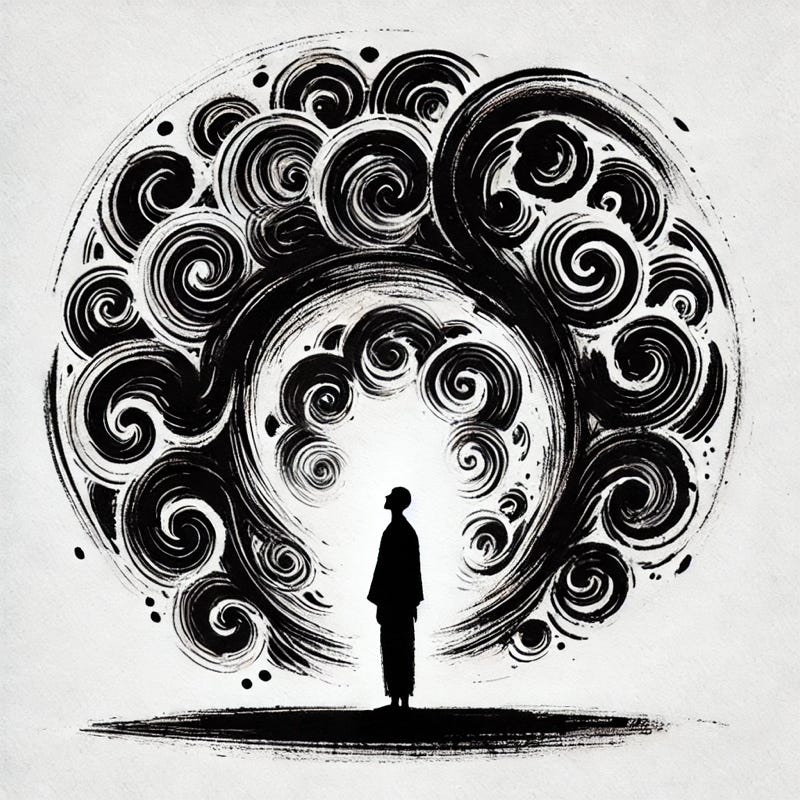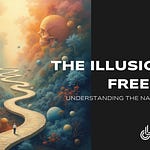Let's talk about the ego and cut through all the nonsense that usually surrounds this topic.
Most conversations about ego start with a flawed logic: that the ego is some kind of villain we need to defeat, some false self we need to transcend, or some obstacle blocking our enlightenment. That framing is oversimplification, and as any oversimplification, counterproductive. It creates this artificial battle between ego and awareness that actually reinforces the very separation it claims to dissolve.
Today we're going to explore a different perspective.
What if the ego isn't an enemy to be defeated, but a natural evolutionary structure of consciousness that undergoes its own metamorphosis?
What if the ego doesn't get dissolved but rather transforms through predictable stages toward full integration with the non-dual awareness that's always been its ground?
The framework I want to share with you stands on the work of some very cool humans who thought deeply about this topic. From Kegan's subject-object theory to Cook-Greuter's ego development work, Torbert's action logics, Loevinger's stage theory, and Spiral Dynamics. They all offer valuable insights that can be assembled together in a map that shows how the ego structure relates to non-dual awareness at each stage of development.
I'm going to walk you through what we can call a "Metamorphic Consciousness Model." If this sounds too fancy, ignore the name. This isn't about fancy terminology. It's about understanding where you are in this evolutionary process and what you can do to catalyze and accelerate your development and give you the metacognitive tools to navigate the existential challenges that inevitably arise at each stage.
Let's dive in.
The 7 Metamorphic Stages of Ego Development
Stage 1: The Embedded Ego
This is where about 75-80% of adult humans operate. At this stage, you're completely embedded within your thought structures. You don't see them - you see through them.
They're not objects of your awareness. They are the lens through which you perceive everything.
The internal narrative here is: "I am my thoughts, roles, and social identity."
When you're at this stage, your cultural programming, conventional thought patterns, and social roles are completely subjective to you - meaning they're not things you can examine; they're things you experience as reality itself. What you can see objectively are concrete behaviours, rules, and basic emotions.
Your cognitive pattern is linear and rule-based. Your worldview is dualistic and oriented toward social belonging. You seek security through conformity.
Here's what's crucial to understand: your metacognitive capacity at this stage is minimal. You don't think about thinking. Your thoughts are your reality.
Eventually, this stage creates its own crisis. Life presents complexities that conventional thinking simply cannot handle. The cognitive dissonance this creates can only be resolved by a fundamental shift in identity.
If you experience glimpses of non-dual awareness at this stage - maybe through meditation, psychedelics, or spontaneous moments of perceived beauty - you'll typically interpret them through religious or mystical frameworks.
You'll see them as "connecting with God" or having a "spiritual experience." These glimpses are seen as special events happening to your separate self rather than revelations of your true nature.
The developmental edge here is recognizing thought patterns as constructed rather than given - this is the initial awakening of metacognitive awareness.
Stage 2: The Self-Authoring Ego
This level of ego maturity represents a major evolutionary leap.
At this stage, you've differentiated from social programming enough to create your own internal value system and sense of identity. You've moved from inheriting meaning to crafting meaning.
The internal narrative shifts to: "I have thoughts, roles, and identities that I can examine and choose."
Now your self-authored identity, personal ideology, and achievement orientation are subjective - they're the water you swim in. But what's become an Object - what you can examine - are social roles, conventional thought patterns, and expectations of other people.
Your cognitive pattern becomes systematic and goal-directed. Your worldview is meritocratic and future-oriented. You seek success through mastery and achievement.
Your metacognitive capacity has expanded significantly. You can now see thoughts as objects, reflect on them, and modify your beliefs. But you still can't see the thinker itself as constructed.
Eventually, the self-authoring ego confronts its own limitations.
Despite achieving success by conventional standards, a sense of emptiness often emerges. The boundaries of your self-authored identity become constraints rather than supports, leading to existential questioning.
Glimpses of non-dual awareness at this stage are often interpreted as insight experiences that enhance performance or creativity. You might incorporate meditation or mindfulness as "techniques" for greater effectiveness, still maintaining the fundamental subject-object split.
The developmental edge at this level is to recognize the constructed nature of the self-authored identity itself - seeing not just thoughts but the thinker as a construction.
Stage 3: The Self-Questioning Ego
At this stage - where about 10-15% of adults operate - you begin to see the limitations of your own construction. Your ego structure becomes more fluid as you question its own foundations.
The internal narrative becomes: "My identity is contextual and constructed; my reality is only the reality of my own mind. There are many valid perspectives."
Now your process orientation, relativistic thinking, and contextual awareness are subjective. What's become an object - what you can examine - is your self-authored identity, personal life philosophy, and achievement orientation.
Your cognitive pattern becomes dialectical. You become increasingly more comfortable with ambiguity and change. Your worldview becomes pluralistic and focused on relationships and context. You seek authenticity through connection and self-expression.
Your metacognitive capacity has evolved to recognize thought systems as relative and identity itself as constructed.
But now, at this stage, the evolutionary tension emerges for you: if all perspectives are relative, how can you act decisively in a complex world?
The relativism that initially liberates eventually leads to a kind of paralysis that can only be resolved through integrating multiple systems into a more adaptive complex system of thought.
Non-dual glimpses at this stage are often interpreted as experiences of "interconnectedness" or "oneness with all perspectives."
You see the self as a fluid process rather than a fixed entity, but there remains an implicit observer watching this fluidity.
The developmental edge involves integrating multiple perspectives without falling into paralysis. You can develop the capacity for both relativistic understanding and decisive execution amidst life's complexity.
Stage 4: The Systems-Aware Ego
This stage represents a quantum leap in complexity - found in only about 4-5% of adults.
Your ego becomes capable of understanding and working with entire systems of thought and organization while maintaining awareness of your participation in these systems.
The internal narrative shifts to: "I operate within systems. And I am simultaneously able to see and transform them."
Systems integration, dialectical awareness, and paradoxical thinking are now subjective. Exploring and reconciling opposing or contradictory ideas or perspectives to arrive at a deeper understanding or truth is now comfortable - it becomes the water you swim in. What's become an object - what you can examine - is your process orientation, relativistic thinking, and contextual frameworks.
Your cognitive pattern evolves to complex systems thinking and polarity management. Your worldview becomes systemic and focused on dynamic complexity. You seek effectiveness through strategic vision and systems transformation.
Your metacognitive capacity now includes awareness of the interaction between observer and observed and recognition of paradoxical and contradicting realities.
The evolutionary tension emerges when you confront a profound recognition: despite your sophisticated understanding of complexity, you remain contained within the fundamental subject-object split of consciousness. This creates a yearning for a more fundamental resolution that transcends even systems understanding.
Non-dual glimpses at this stage often reveal how the observer itself is part of the system being observed. These glimpses point toward the constructed nature of the observer-observed distinction, which creates openings to a more fundamental recognition.
The developmental edge for you involves recognizing the construct-generating nature of consciousness itself. It is developing the ability to see not just systems of thought but the fundamental structure of cognition that creates all systems.
Stage 5: The Construct-Aware Ego
Found in less than 1% of adults, this stage represents a fundamental shift where consciousness begins to observe its own construct-making nature.
Your ego recognizes itself as a process rather than an entity, aware of the mechanisms through which it constructs reality.
The internal narrative becomes: "I can witness the very processes through which my mind constructs all my experience, my reality, and my identity."
Awareness of awareness, witnessing capacity, and transpersonal perspective become subjective. What's become object - what you can examine - are systems thinking, dialectical frameworks, and the self as a complete manufactured construct.
Your cognitive pattern evolves to meta-theoretical thinking and paradigm recognition. Your worldview becomes construct-aware and meta-systematic. You seek authenticity through self-transcendence and witnessing awareness.
Your metacognitive capacity now includes awareness of awareness itself and recognition of the ego as a convenient fiction - a Concept of Self that exists and being used for practical purposes.
The evolutionary tension is profound: you use ego structure to recognize the constructed nature of the ego itself.
This creates a tension between being and becoming, between awareness and its objects, that drives toward a fundamental non-dual recognition.
Non-dual glimpses at this stage reveal not just the illusory nature of the separate self but the empty nature of awareness itself. These glimpses become more and more stable. And you develop the ability to see how they point directly to the paradoxical nature of consciousness that both transcends and includes all constructs.
The developmental edge involves the paradoxical integration of emptiness and form. Learning how to recognize the constructed nature of all experience while fully participating in the world of form.
Stage 6: The Unitive Consciousness
Exceedingly rare in the adult population, this stage represents the integration of non-dual awareness with the relative world of form.
The ego structure has been so thoroughly seen through that it becomes transparent to awareness, neither rejected nor identified with.
The internal narrative dissolves into: "There is only This - consciousness appearing as all forms while transcending all forms."
At this stage, the subject-object distinction itself becomes transparent.
Your worldview becomes non-dual, immediate, reflecting the paradoxical unity of emptiness and form. Your cognitive pattern shifts to immediate knowing and profound simplicity. You feel constant compassion and freedom within form.
Your metacognitive capacity evolves to transparent witnessing that doesn't separate from what is witnessed.
Even at this stage, subtle traces of the subject-object split can emerge under stress, creating a tension between unitive being and habitual thinking patterns of separation.
Non-dual recognition is no longer a glimpse but the natural resting state, though fluctuations in the clarity of this recognition may still occur.
The paradox of being both no one and everyone simultaneously is lived, and not just merely understood.
The developmental edge involves the embodiment of non-dual awareness in all dimensions of life - psychological, relational, and practical.
Stage 7: The Integrated Consciousness
This extraordinary stage - essentially theoretical for most of us - represents the full embodiment of non-dual awareness across all dimensions of being.
This is Jesus / Buddha / God-level consciousness.
It's characterized by the seamless integration of absolute (non-dual awareness) and relative (the world of form and distinction).
The internal narrative, if we can even call it that, becomes: "Awareness and its expressions are not two. Ordinary life is revealed as the perfect expression of ultimate reality."
Subject-object distinctions become completely transparent; distinctions arise within non-dual awareness without creating separation. Your worldview becomes integrated and non-dual - "form is emptiness, emptiness is form."
Your cognitive pattern shifts to spontaneous wisdom appropriate to each situation. You naturally express compassion that arises from the recognition of interbeing.
Your metacognitive capacity evolves to effortless meta-awareness that doesn't create division.
Even at this advanced stage, the integration of awareness and form continues to deepen, with increasingly subtle patterns of separation being recognized and released.
Non-dual awareness is fully integrated with everyday consciousness. There is no special "spiritual state", no “enlightenment” to achieve because ordinary consciousness is recognized as already complete.
The developmental edge involves the endless deepening of embodiment and the increasingly subtle expressions of wisdom in everyday life.
From here there is a path of Absolute Mastery.
A path of no path.
5 Key Takeaways from this Ego Evolution Model.
This metamorphic model completely transforms how we understand ego development.
Let me summarize 5 key insights from this model:
1. The Ego is not an Enemy but an Evolutionary Structure
Look, you will find plenty of spiritual teachers who will frame the ego as this obstacle to be eliminated. That's simplistic and misleading. The ego is an evolutionary structure of consciousness that naturally develops toward greater complexity and deeper integration. The goal is not to destroy the ego but to transform it from an opaque structure that obscures awareness to a transparent vehicle through which awareness expresses itself. This is a journey from full identification to full seeing through the entity you have been identifying with all your life.
2. Development occurs through resolution of Evolutionary Tensions
Each stage of ego development creates specific tensions or limitations that can only be resolved through transformation to the next stage. These evolutionary tensions are not to be seen as problems to be solved. See them as the catalysts for growth. Understanding your current evolutionary tension gives you the precise leverage point for accelerating development. Attain the understanding of what is in the way - and that tension or limitation itself becomes the way.
3. Non-Dual glimpses function differently at each stage
This is crucial to understand: experiences of non-dual awareness - whether through meditation, psychedelics, or spontaneous recognition - are interpreted and integrated differently depending on your developmental stage. This explains why the same mystical experience can lead to fundamentalism in one person and profound wisdom in another. Your developmental context determines how non-dual glimpses are understood and integrated.
4. Metacognitive Capacity will increase with each stage.
Each stage brings a higher order of metacognitive awareness - the ability to observe and work with your own cognitive processes. This increasing metacognitive capacity is what allows for greater flexibility, complexity, and eventually, the recognition of awareness itself.
5. Development is not linear and not random
While the stages unfold in a generally predictable sequence, development is neither strictly linear nor entirely random. You likely have aspects of yourself at different stages simultaneously. You may temporarily regress into a lower stage under stress. You may experience temporary states characteristic of more advanced stages. Both things can happen. Just keep this in mind, consider this model as a representation of a center of gravity rather than an absolute positioning.
How to Apply This Model in Your Life
Understanding the Metamorphic Consciousness Model isn't just theoretical - it has powerful practical applications.
For your personal development, you can now:
Recognize the specific limitations of your current stage
Understand why certain patterns keep recurring despite your best efforts
Design precise practices that address your actual developmental edge
Make sense of non-dual glimpses within your developmental context
Navigate the existential challenges that emerge during stage transitions
If you're a coach, therapist, or leader, this model gives you:
A framework for meeting others exactly where they are developmentally
The ability to design interventions appropriate to specific developmental stages
Understanding of why certain approaches work with some clients but not others
Recognition of how to facilitate genuine vertical development and not just horizontal skill-building
Calibrate your language to make developmental challenges explicit without creating unnecessary resistance
For those of you on a spiritual path, this model:
Integrates psychological development with spiritual awakening
Explains why the same spiritual practices yield different results for different practitioners
Provides a roadmap for the integration of non-dual glimpses
Resolves apparent contradictions between different spiritual teachings
Guides the embodiment of awareness in everyday life
One more thing: hold this model lightly
While the Metamorphic Consciousness Model provides a powerful framework for understanding ego development, remember that this model itself is a construct of consciousness.
At the highest levels of development, you must be willing to hold the model lightly - using it when helpful and putting it aside when it becomes a limitation.
The ultimate wisdom lies not in rigidly applying any model but in the fluid recognition that all models are just that - models.
They can be both simultaneously true and limited.
This is a paradoxical stance. You can both use conceptual structures and at the same time recognize their constructed nature.
This stance represents the integration of relative and absolute perspectives that characterizes the most advanced stages of consciousness.
The Journey Beyond the Journey
Here's the paradox our today’s exploration reveals:
We develop through stages toward the recognition that development itself is ultimately an appearance within the awareness that has never needed to develop.
The ego undergoes a transformation from a solid, opaque structure that obscures awareness and non-dual seeing to a transparent vehicle through which awareness shines and expresses itself in the world.
This journey isn't about becoming someone new. It is more about Unbecoming. That which we call Self-Realization can may as well be called Unself-Unrealization.
Each stage of development brings us closer to the recognition that awareness itself - the ground of all experience - has been there all along - present from the beginning. The journey doesn't lead to a new state but to the recognition of what is already and always here.
The so-called journey of evolution is simply the Awareness learning how to recognize itself as the Construct of Ego dies away.
Yet from another perspective, this journey is absolutely real and necessary.
The relative and the absolute, being and becoming, emptiness and form - all these apparent opposites are revealed as expressions of the same reality.
Our development through stages is simultaneously real and illusory. It is necessary yet somehow it is already complete.
This is the ultimate wisdom of the Metamorphic Consciousness Model: to honour both the journey and the recognition that there has never been anyone journeying.
In that paradoxical recognition lies freedom - the freedom to fully participate in the unfolding of universal consciousness while resting in the infinite awareness that has always been here.
The ego doesn't end.
It simply transforms into a transparent expression of the awareness that has always been its true nature.



















